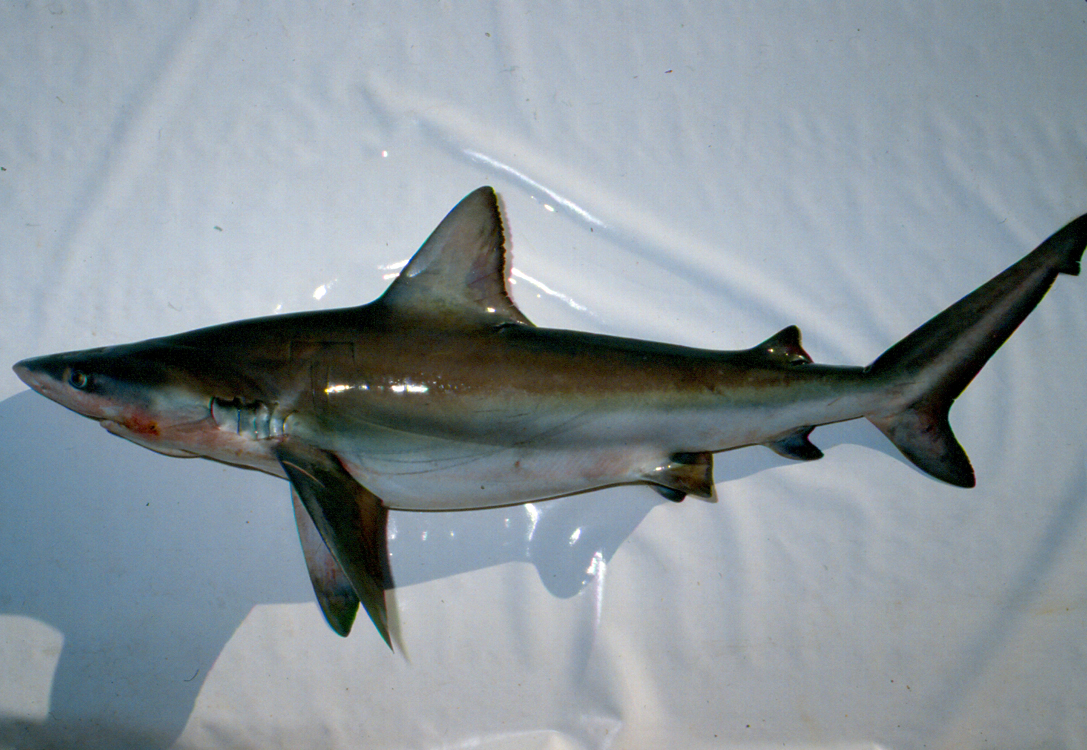Bignose Shark, Carcharhinus altimus (Springer 1950)

Bignose Shark, Carcharhinus altimus. Source: Apex Predators Program, NOAA / NEFSC. License: CC BY Attribution
Summary:
A heavy bodied greyish shark becoming white below, long almost straight pectoral fins with blackish inner corners, and no conspicuous markings on the body. The Bignose Shark has a large, long and broad snout, with long nasal flaps and high, triangular, saw-edged teeth in the upper jaw, and a high, prominent interdorsal ridge.
Cite this page as:
Bray, D.J. 2018, Carcharhinus altimus in Fishes of Australia, accessed 20 Apr 2024, https://fishesofaustralia.net.au/Home/species/2879
Bignose Shark, Carcharhinus altimus (Springer 1950)
More Info
|
Distribution |
Cape Leeuwin to the North West Shelf, Western Australia, and the Gulf of Carpentaria and the Great Barrier Reef, Queensland, to off Newcastle, New South Wales. Elsewhere the species is circumglobal in tropical and warm waters. Usually inhabits deep offshore waters near the edge of the continental shelf, usually below 80 m. |
|
Fisheries |
Taken as bycatch in deep set pelagic longline fisheries, and occasionally in bottom trawls. |
|
Species Citation |
Eulamia altima Springer 1950, American Museum Novitates 1451: 9. Type locality: Florida Keys, USA. |
|
Author |
Bray, D.J. 2018 |
|
Resources |
Bignose Shark, Carcharhinus altimus (Springer 1950)
References
Anderson, R.C. & Stevens, J.D. 1996. Review of information on the diurnal migration in the Bignose shark (Carcharhinus altimus). Marine and Freshwater Research 47: 605-608.
Compagno, L.J.V. 1984. FAO Species Catalogue. Sharks of the World. An annotated and illustrated catalogue of shark species known to date. Carcharhiniformes. FAO Fisheries Synopsis No. 125. Rome : FAO Vol. 4(2) 251-655 pp.
Compagno, L.J.V., Dando, M. & Fowler, S. 2005. A Field Guide to the Sharks of the World. London : Collins 368 pp.
Compagno, L.J.V. & Niem, V.H. 1998. Family Carcharhinidae. pp. 1312-1360 in Carpenter, K.E. & Niem, V.H. (eds). The Living Marine Resources of the Western Central Pacific. FAO Species Identification Guide for Fisheries Purposes. Rome : FAO Vol. 2 687-1396 pp.
Garrick, J.A.F. 1982. Sharks of the genus Carcharhinus. National Marine Fisheries Service (U.S.). Technical Report 445: 1-194 figs 1-83
Last, P.R. & Stevens, J.D. 1994. Sharks and Rays of Australia. Canberra : CSIRO Australia 513 pp. 84 pls.
Last, P.R. & Stevens, J.D. 2009. Sharks and Rays of Australia. Collingwood : CSIRO Publishing Australia 2, 550 pp.
Macbeth, W.G., Vandenberg, M. & Graham, K.J. 2008. Identifying Sharks and Rays; A guide to Commercial Fishers. Sydney : New South Wales Department of Primary Industry pp. 71.
Pillans, R., Amorim, A., Mancini, P., Gonzalez, M. & Anderson, C. 2009. Carcharhinus altimus. The IUCN Red List of Threatened Species 2009: e.T161564A5452406. http://dx.doi.org/10.2305/IUCN.UK.2009.RLTS.T161564A5452406.en. Downloaded on 28 November 2018.
Springer, S. 1950. A revision of North American sharks allied to the genus Carcharhinus. American Museum Novitates 1451: 1-13 http://hdl.handle.net/2246/4236 Open access
White, W.T., Last, P.R., Stevens, J.D., Yearsley, G.K., Fahmi & Dharmadi. 2006. Economically important sharks and rays of Indonesia. ACIAR Monograph series, 124: 1-329 Ref available online





